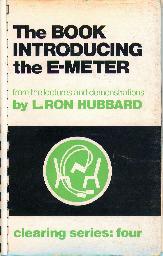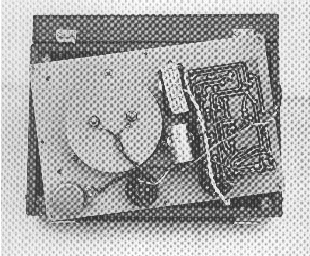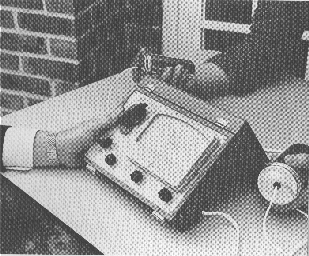Review and commentary:
The Book Introducing The E-Meter
by L. Ron Hubbard
Softcover, 47 pages. Available from Bridge
Publications Mail Order, 4751 Fountain Ave., Los Angeles CA 90029, or call
1-800-843-7389. In Europe, order from New Era Publications Int. ApS, Store
Kongensgade 55, 1264 Copenhagen K, Denmark. 1995 price US $40.
Note: all images accompanying this book review are copyright 1966, 1968,
or 1983 by L. Ron Hubbard. They are reproduced here under the ``fair use''
provision of the US copyright code.
 Cover of the
1983 edition.
Cover of the
1983 edition.
The insignia on the cover shows two facing chairs (as in an
auditing session) with an e-meter between them. The edition offered for sale in
1995 has a more modern cover design based on the Mark Super VII meter, but since
it is a crime in Scientology to alter any of Hubbard's writings, one may assume
that the text and photographs will never be updated.
This book, first published in 1966, was supposedly compiled from lectures and
demonstrations given by L. Ron Hubbard. The compilers are never identified.
Hubbard, who is referred to throughout in the third person, and with obsequious
respect, is named in the frontmatter as the book's copyright owner. It seems
likely that he is also the author.
The book describes the Mark V e-meter, the last simple model in the e-meter
line. First issued in 1962, the Mark V uses a few transistors mounted on a
single printed circuit board. (See Homer Wilson Smith's e-meter
schematic for the essence of the design.) Its successor, the Mark VI, was an
all-new design released in the 1980s using microprocessor technology, and is
substantially similar to current top-of-the-line model, the Mark Super VII.
The venerable Mark V is still in use in Scientology today, retailing in 1995
for US $625. It is promoted as a training meter for student auditors, and as an
inexpensive back-up meter, since all professional auditors are required to own
two. ($625 may sound like a lot of money for such a simple device, but the more
sophisticated Mark Super VII is far more dear at US $3,850.) Although The
Book Introducing The E-Meter is now thirty years old, it still offers timely
data for would-be Scientologists.
Candid Introduction
The book begins with a surprisingly candid
introduction:
This is a Hubbard Electrometer called an E-Meter for short.
Technically it is a specially developed ``Wheatstone Bridge'' well known to
electrically minded people as a device to measure the amount of resistance to
a flow of electricity.
Critics of Scientology sometimes deride
the e-meter as ``an overpriced ohm-meter'' or ``just a wheatstone bridge''. Here
we see Hubbard himself making this admission. Technically, the e-meter is an
ohm-meter with continuously variable range and sensitivity settings.
 Click for
full-scale image.
Click for
full-scale image.
The printed circuit board of the Mark V reveals the
simplicity of the design.
As in most of its literature, here Scientology will be mixing a little fact with
a lot of fiction. The hype begins almost immediately. On p. 6 we see a
photograph of Hubbard checking a new Mark V against what it supposedly the
prototype. ``This prototype is kept by Ron in a safe and is used by him from
time to time to make sure that the standard of manufacture is maintained. It was
made to his exact specifications and assembled in a Mark IV case.'' And we are
told again on p. 9 that the Mark V is ``made to Ron's exact specification'', and
that it is a ``precision instrument''. The fact that it's just an ohm-meter has
apparently been forgotten, and no specifications for the true precision of the
instrument are ever given, here or in any other Scientology publication. And
another contradiction: on p. 28 we're told that in choosing electrodes for the
meter,
Ordinary "tin" cans with the paper label stripped off are
preferred. Although they are less attractive, they give a more accurate
response.
Less accurate than what? And how can the electrical
properties of ordinary tin cans, manufactured for an entirely different purpose,
be sufficiently uniform to qualify them for use with a ``high-precision''
resistance meter? No alternative sources of electrodes are mentioned in the
book, but all the illustrations show clean, shiny cans with scew-on lids. In the
center of each lid is a rubber grommet through which a wire enters. (See picture
below.) These reasonably attractive looking electrodes are obviously custom jobs
-- precisely what Hubbard is advising not to use.
The Measurements of the E-Meter
Another surprising statement appears on
page 3:
The resistance of a dead female body is 5,000 ohms and of a
dead male body, 12,500 ohms.
The alert reader is thus warned
early on that the author is a quack, or to put it more charitably, has a limited
understanding of biophysics. It is unusual in Scientology publications to begin
with the most obviously loony bits; typically one has to wade through many pages
of vague definitions and undocumented claims before discovering the true nature
of the material.
The 5,000 and 12,500 ohm values have special significance in Scientology.
They correspond to Tone Arm settings of 2 and 3, marked on the Tone Arm dial
with an F and an M, respectively. In a normal auditing sesssion, the TA must be
between 2 and 3 at the start of the session; the auditor adjusts things until
this is so. However, on page 4 of the book we read:
When, however, the resistance of a live body is measured it can
be as low as 500 ohms or as high as 1,000,000 ohms. These figures are
mentioned as a matter of interest and to show the wide divergence of the
electrical resistance of a body when it is inhabited.
On pages
35-39 we are given another example of the great significance placed on body
resistance values as measured by the e-meter. One of the tests that must be
passed to become a Class VI auditor is that, while holding the electrodes, the
Tone Arm value with the needle at the set-point should be between 2.0 and 4.0. A
value of 4.5 is considered barely passing; 5.0 or higher is a failure, as is any
value below 2.0. Presumably, an individual whose Tone Arm setting cannot be
brought within the ``normal'' range is too mentally unhealthy or spiritually
unworthy to be a Class VI auditor. However, in other publications the
Scientologists acknowledge that people with unusually dry hands may require some
skin moisturizer in order to make a good contact with the electrodes. One
wonders how many auditor candidates have availed themselves of this solution to
their spiritual problems.
What The Meter Does
The basic claims for what the e-meter does (besides
measure body resistance) are summarized in the statement below, taken from pages
5 and 6:
Tests conclusively show that an individual's emotional state,
his thoughts, etc., instantly raise or lower the electrical resistance of the
body. Thus the meter is an extremely valuable tool in the hands of a trained
auditor... We in Scientology have come to accept the fact that the E-Meter
``talks'' to us.
We rarely give much thought to the hours and hours of work and research put
in by L. Ron Hubbard, resulting in the perfect instrument -- the Mark V -- and
an exact exposition of what the various readings and changes mean.
How much credence should we give to these claims? Is the
Church willing to stand behind them? From the copyright page:
This book is part of the works of L. Ron Hubbard who developed
Dianetics spiritual healing technology and Scientology applied
religious philosophy. It is presented to the reader as a record of
observations and research into the nature of the human mind and spirit, and
not as a statement of claims made by the author.
In other
words, ``This stuff is not supposed to be factual; it may well be rubbish. Don't
try to hold us responsible. Hubbard wrote it; we publish it.'' From the same
page:
The Hubbard Electrometer, or E-meter, is a device which is
sometimes used in Dianetics and Scientology. In itself, the
E-meter does nothing. It is not intended or effective for the diagnosis,
treatment, or prevention of any disease, or for the improvement of health or
any bodily function.
This despite the fact that Scientology
claims that 70% of all illness is psychosomatic and can be cured with auditing!
Operating The Meter
The bulk of the book is devoted to the mechanics of
setting up the meter and demonstrating the controls. Discussion of these topics
runs from page 10 through page 39. Here is a summary of the controls of the Mark
V:
- The Tone Arm is the range control. With the Tone Arm set to 2, the needle
will be centered when the resistance across the elctrodes is 5,000 ohms.
- The sensitivity knob controls the meter's sensitivity to resistance.
(Technically, it sets the gain on the amplifier circuit that drives the
needle.) It ranges from 1 to 16 (or 32 in later models); a normal value is
around 4. When turned fully counter-clockwise, it shuts the meter off.
- The sensitivity booster knob gives coarse-grain control of the meter's
sensitivity. It has three settings: 16, 32, and 64.
- The set/transit/test switch is normally left in the ``set'' position. It
is switched to ``test'' to check the battery; a full-scale needle deflection
to the right indicates that the battery has sufficient charge. The switch
should be moved to the ``transit'' position when shipping the meter for
repairs, or any time the meter is not in use. This protects the needle
movement.
- The trim knob allows the operator to adjust the needle position without
moving the Tone Arm. It is used to calibrate the meter by setting the Tone Arm
to 2.0 and adjusting the trim until the needle is at the set-point on the
dial.
- The tone arm counter is an mechanical accumulator that may be attached at
the bottom of the tone arm knob to tally downard (counter-clockwise) motion of
the Tone Arm. This supposed to indicate the total ``charge'' released during
an auditing session.
 Click for
full-scale image.
Click for
full-scale image.
A typical auditing session. The preclear holds the cans
(electrodes) in his hands. The auditor's left thumb rests on the Tone Arm knob,
so he can continually and unobtrusively manipulate it during the session.
Needle Actions
The book concludes with a summary of the major ``needle
actions'' (types of motion) that may be observed during auditing. Supposedly
there are 10 of these, although later, more advanced publications claim around
20. Only a few are actually explained in this book. The 10 actions listed are:
- Stuck needle: ``You ask the pc a question and the needle just stays
stuck with no movement whatsoever.'' The term pc means pre-clear: the
person undergoing auditing.
- Null: the needle continues to behave in whatever way it was doing, showing
no influence of the auditing question.
- Fall: the needle moves to the right. In more advanced texts this class is
subdivided into short falls, long falls, and long falls with blowdown (needle
goes offscale, requiring Tone Arm readjustment.)
- Rise: the needle moves to the left.
- Theta bop: a rapid back-and-forth dance of the needle, from 1/8 to 1/2
inch wide, at a rate of 5-10 times per second. In more advanced texts it is
revealed that a theta bop is seen when the thetan (spirit) is repeatedly
leaving and reentering the body.
- Rock slam: a rapid, irregular, jerky motion of the needle, varying in
width. ``The needle goes crazy.'' Significance is unexplained here, but in
other literature it is revealed that a rock slam indicates that the pc has an
Evil Purpose.
- Stage Four: the needle repeatedly rises an inch or two, sticks, and then
falls, about once per second. It is unaffected by auditing commands.
- Floating needle, often abbreviated F/N: slow, smooth movement over a wide
range. This indicates the conclusion of an auditing acitivity. It is a crime
in Scientology to pursue a process beyond a floating needle.
- Change of characteristic: no details given.
- Body reactions: not explained here, but these are artifacts caused by body
motion, such as the preclear yawning, coughing, moving around in the chair, or
lifting a finger off the cans.
Conclusion
Although this is a short book on a narrow subject, to the
perceptive reader it reveals much of the feel of Scientology. There is a
smattering of science (``ohms'' and the ``wheatstone bridge''), a bit of the
supernatural (bodies being ``inhabited''), some obvious lunacy (dead female
bodies are 5,000 ohm resistors), a dose of mystery (unexplained needle actions,
special tests for Class VI auditors), and much reverence for the founder, L. Ron
Hubbard. Given Hubbard's obviously limited scientific understanding, one wonders
whether he contributed anything at all to the design of the transistorized Mark
V, though he is credited here as its developer. No mention is made of Volney
Matheson, the man who designed the original e-meter. In Understanding the
E-Meter, p. 97, Hubbard claims to have invented it himself.
The Book Introducing the E-Meter, this modest little 47 page softcover
volume with black-and-white photographs dating from the 1960s, was being offered
in 1995 for the outrageous price of US $40. That, too, makes it a telling
introduction to Scientology.
Return to main
e-meter page
 Cover of the
1983 edition.
Cover of the
1983 edition. Click for
full-scale image.
Click for
full-scale image. Click for
full-scale image.
Click for
full-scale image.